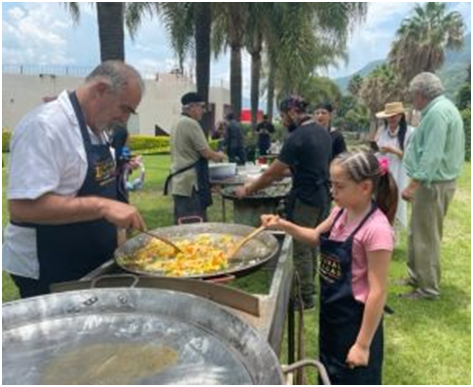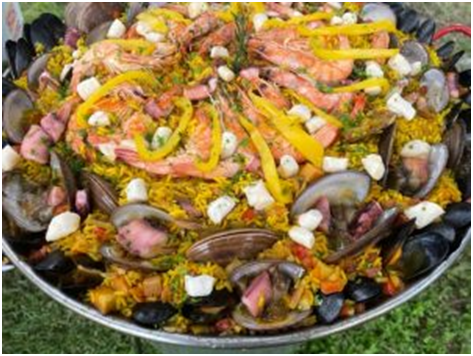FIRST PAELLA FESTIVAL OF LAKE CHAPALA
WHEN RICE BECAME A PARTY
By Juan Carlos Núñez Bustillos on Jaliscocina.com
The aroma of onion and bell pepper, when falling on the very hot olive oil, announced the start of the First Festival of Paellas of Lake Chapala. From each of the five stoves lined up in the garden began to emanate the fragrant smells that were the prelude to the feast of flavors that was to come.
Black Paella. Foto: JCN
On the slopes of the San Juan Cosalá, in a garden with a wonderful view of the lake, the contenders gathered around the paellas; the extended and round pans bear the same name as the dish that is prepared in them.
La Arrocería del Lago organized the festival. Foto: Elba Castro
On the work tables, the ingredients were the best decoration: green, yellow and orange peppers, onions, clams, mussels, squid, green beans, shrimp, crab, scallops, sausages, bacon, asparagus, chicken, green beans, cauliflower, zucchini , paprika, habaneros… and the sacred saffron.
The cooks, the eldest of 65 years and the youngest of eight, began to show off their culinary arts, but, above all, their good humor and camaraderie. Because, unlike the culinary contests so fashionable in which the contenders suffer and are humiliated, the Lake Chapala Paella Festival was, above all, a space for coexistence and joy. Teams helped each other, handed out ingredients, applauded each other, and toasted.
The eldest and youngest of the cooks. Foto: JCN
The organizer of the festival is Paco Romero, “architect by profession and cook by vocation”. On a trip to Valencia, Spain, he fell in love with paella and learned how to cook it. Regarding his initiative to create the paella festival, the promoter of Arrocería del Lago commented: “I am going to come to live here, so this festival is my welcome to the lake and the lake to me. The participants are basically amateurs, people who like to make rice dishes. I hope that the festival will grow and that professionals will also join in future editions”.
What does paella mean to you?
“Paella is a cultural expression that has been evolving. At the beginning it was a dish for workers who prepared rice with vegetables from the fields where they worked; with what they hunted, like hares, or the snails they collected. Later it was prepared with the leftovers that were available. Now it is a dish to which the most varied ingredients are added. There are as many types of paellas as there are houses. Each paella is different”. This was verified by those attending the festival, which was held last Saturday August 20th, 2022, as each of the five competing teams cooked a different paella.
For Every Taste
The first was a black firewood paella. It was prepared by the team led by Luciana Amaral, 18, a Gastronomic Business Management student. Her father, Luis, and Cristian Ramal completed the team. Luis explained: “It is a paella with little seafood, it only has rings of squid and shrimp. It is served with alioli and the firewood gives it a smoked flavor”.
Black paella preparation. Foto: JCN
In the next stove Fideuá with seafood and vegetables was prepared. “In this case instead of rice, we use noodles. The rest is the same as a paella, both in the procedure and in the ingredients”, expressed Paco Romero, the cook.
Cooking the vegetarian paella. Foto: JCN
Next door, Álvaro Vallejo commanded the team that prepared the vegetable paella. His eight-year-old granddaughter Isabela was the most enthusiastic cook who also helped other teams. Three-color peppers, green beans, asparagus, zucchini, mushrooms, cauliflower, and ground tomato accompanied the rice. The fourth team made up of Rocío Mellón, Fernando Mayorga, Carlos Ortiz and the Argentinian Gabriel García, prepared a seafood paella. "The secret is the fumet (fish and shellfish broth), it must be boiled for a long time, between an hour and a half to two hours, so that the flavor is well concentrated," said Gabriel.
Surf and turf paella. Foto: JCN
The fifth team was the most daring because they decided to make a land and sea paella, Mexican and Spanish, which included paprika, cayenne and habanero pepper. Fernando Sánchez, Cristina Gutiérrez, Carolina Ibarra and Ángel Omar Manrique cooked their rice with Spanish chorizo and bacon, as well as mussels, shrimp, clams, scallops, crab and squid. “And a touch of habanero. We remove the seeds and the veins so that it doesn't get too spicy and only gives it flavor,” Fernando commented.
The smells whetted the appetite of the diners who kept arriving and arriving; those who had confirmed and also more than one freeloader.
Cooked On A Live Fire
Adding the smoked flavor. Foto: JCN
The aromas of the first sauces were followed by the one released when the fumets were added. The emptying of the broths was a first challenge for some contenders. The slight slope of the terrain tilted the liquid to one side. "It's not going to cook evenly," said one of the cooks. A practical man, Carlos Ortiz, took one last sip of his canned beer, crushed it with his foot, shaped it with his hand, and with it he leveled the paella. With the same technique he helped the neighboring team. He had previously solved a technical problem in one of the grills.
One by one the ingredients fell into the paellas. In each stove the delight to the eye grew and just as the food was brought together, the voices also intermingled: “Fry all the shells now”, “fry it for five minutes, just until it takes on color”, “How delicious the bell peppers smell!”, “stir slowly”, “there is no better smell than that of frying garlic”, “where is my shovel?”, “the salt at what time?”, “whoever starts the paella has to finish it ”…
Adding the rice in the shape of a cross. Foto: JCN
The land and sea paella team added the rice in the shape of a cross. With devotion, Luis took the saffron out of a kind of reliquary to integrate it into the black paella.
A new challenge appeared in one of the stoves. The flame was very low. Solidarity; the team next door that had a better fire agreed to change places. It was a critical moment because a paella with a lot of liquid is easily unbalanced and the probability of it turning out wrong is enormous. Gabriel, the Argentine, was the volunteer to make the "step of death". With the same sense of balance that he has tattooed on his arm, he overcame the challenge.
The Gran Finale
The final Surf & Turf paella. Foto: JCN
In the last stage, the paellas were covered with aluminum foil to finish cooking, slowly. The tables were already full and people kept arriving.
Those who wanted to refresh their palates and spirits were able to do so from the beginning because a new artisanal craft beer, Jibia was offered for sale, in its blonde and dark presentations. An Andalusian gazpacho also delighted the guests. It was the announcement that the expected moment was near. At times concern grew because a couple of thick clouds threatened to turn into rain. But the lake welcomed Paco Romero and only a very light drizzle arrived that refreshed the atmosphere and whetted the appetite even more.
"Ready". The aluminum foils were lifted to reveal images worthy of a postcard, because the chefs also insisted on the aesthetics of the preparations. In a moment a line of diners was formed and in an instant the rice dishes also flew, except for the Fideuá that required a little more time and was a good excuse for a second round.
Dessert: Coco Pie Paleta. Foto: JCN
The drinks that accompanied the paellas were red wine and beer. Dessert consisted of Pay de Coco popsicles, a recipe created by Tania Romero, owner of “Pay de Co”. As diners enjoyed the sweet ending, they cast their votes on the contestants. The winning paella was the black one, followed by the sea and land. The vegetarian took third place.
The First Paella Festival of Lake Chapala was thus concluded with a clear sign of success in that there was not one grain of paella left at the end.









